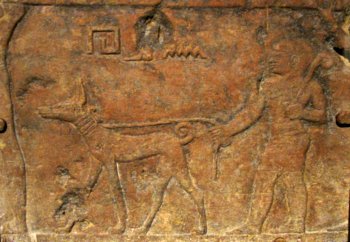by Annie Shanley (Atlanta Science Tavern Contributor)
Dogs were popular pets in ancient Egypt and were the objects of genuine affection by kings, nobles, and laborers. While not all ancient animals were given names, over 75 dog names have been identified and usually refer to the color or character of the dog. That owners cared for their dogs in this life is apparent by the veterinary papyri uncovered from ancient Egypt. Pets also shared in the afterlife with their owners as evident by their inclusion in tomb scenes and human burials.

Tomb relief, 5th Dynasty, c.2465-2323 BCE. Limestone. MCCM 2006.10.1. Gift of Wayne and Ellen Bailey to the Michael C. Carlos Museum. Photo by Annie Shanley
When looking at depictions of dogs in ancient Egyptian art, scholars and general audiences are eager to determine what type of dog is being shown. Beginning in the Predynastic Period (c. 4000 BCE) the most commonly portrayed dog is a type of hunting hound with erect pointed ears and a short curly tail. This dog is often referred to as a Pharaoh Hound, an Ibizan Hound, or a Basenji.
But what about the actual remains of dogs? Bones recovered from archaeological sites have not been subjected to systematic studies, but those bones that have been examined belong to mutts. Recent DNA research into modern dog breeds may help point us in the right direction. Based on preliminary findings, the Basenji can be positively classified as an “ancient dog breed”, while the Pharaoh Hound and Ibizan appear to be more modern breeds. The Pharaoh Hound originates from Malta, and the name was given to the breed during the 1920’s because they look like the dogs in Egyptian art. The Ibizan Hound was first identified on the island of Ibiza off the coast of Spain. While it is true that more comprehensive DNA testing needs to be conducted, and the impact of selective breeding needs to be taken in to account as well, DNA science does offer exciting possibilities for identifying ancient Egyptian man’s best friend.
Annie Shanley is a doctoral student in the Art History Department at Emory University. Her research interests include the material culture and technology of Egypt, the Near East, and the ancient Mediterranean, Egyptian texts, and ancient trade. Annie’s current work focuses on glass and faience in Egyptian and Hittite texts.
This post first appeared at Wonders & Marvels on 14 February 2012.
